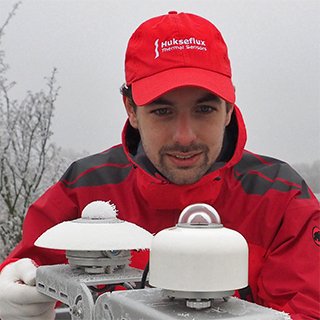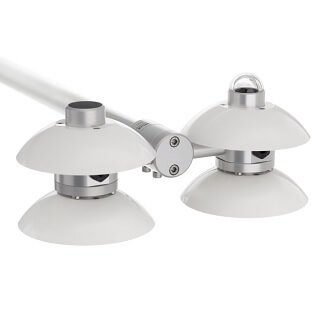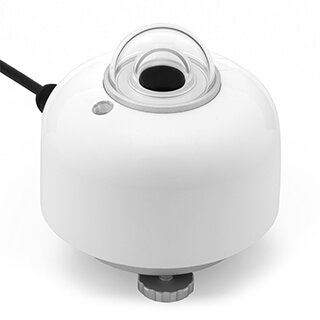Solar irradiance sensors in weather stations: utilising pyranometers and pyrgeometers
Solar irradiance sensors, like pyranometers, measure the amount of shortwave radiation the earth receives from the sun. Solar irradiance is the largest source of energy for planet earth and plays a key role in weather and climate patterns. Therefore, solar irradiance sensors are crucial components in weather stations to obtain high-quality data for weather forecasting and climate research.
The earth’s surface emits longwave radiation, which is an important measurand for long-term climate research or frost detection. That is why some weather stations include longwave irradiance sensors like pyrgeometers. Certain weather stations even include a net radiometer, which measures both the shortwave solar irradiance and the earth’s longwave irradiance.
This article provides the most important information regarding solar irradiance sensors and longwave irradiance sensors in weather stations. We explain solar irradiance and its effect on the weather, the use of pyranometers in weather stations, and when pyrgeometers are included in weather stations.
The impact of solar irradiance on the weather
Before explaining the impact of solar irradiance on weather patterns, it is important to clarify what solar irradiance exactly is. Solar irradiance is the power per unit area received by a surface from the sun. It forms the most important source of energy for planet earth and heats up the oceans, surface and atmosphere of the earth.
Everybody is familiar with at least one effect that solar irradiance has on the weather: seasons. A higher solar irradiance heats up the environment during summer. Contrarily, there is less solar irradiance in the winter, leading to colder temperatures.
However, solar irradiance is actually the major driver behind all aspects of earth’s climate. It directly affects cloud formation via evaporation, regulates carbon dioxide concentrations via photosynthesis and creates wind patterns via the uneven heating of the earth’s surface.
Clearly, solar irradiance is vital for weather and climate patterns. Therefore, to accurately predict the weather or understand long-term climate change, reliable measurements of solar irradiance are crucial. This is where solar irradiance sensors, like pyranometers, come into play.
Solar irradiance sensors in weather stations
Weather stations have many different uses, from providing accurate data for weather forecasting, to monitoring environmental conditions relevant to agriculture. Regardless of the application, almost all weather stations will need solar irradiance sensors. However, the type of sensor and its orientation will depend on the application of the weather station.
Below, we will summarise the three most important considerations for selecting solar irradiance sensors.
1. Type of measured solar irradiance
There are several types of solar irradiance that a weather station can measure. Here we will discuss measuring the Global Horizontal Irradiance (GHI), Diffuse Horizontal Irradiance (DHI), and surface reflected irradiance.
Typically, most weather stations measure the Global Horizontal Irradiance (GHI), which is the total irradiance that a flat surface on earth receives. Global irradiance consists of direct sunlight and sunlight scattered by the atmosphere, known as diffuse irradiance. The GHI is an important measurement for most weather stations since it measures how much energy the sun provides to the earth’s surface. This is vital for understanding evaporation and changes in surface temperature. A horizontally installed pyranometer is an excellent option for measuring the GHI.
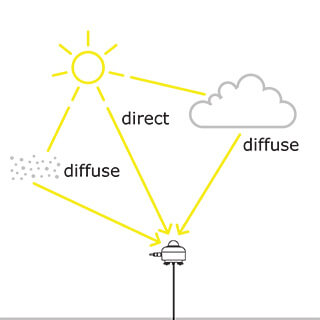
direct sunlight and diffuse sunlight. It gives the total
amount of irradiance that a horizontal surface receives.
Some specialised weather stations also measure the diffuse horizontal irradiance (DHI), defined as the GHI minus the contribution of direct sunlight. The DHI plays an important role in plant photosynthesis, as diffuse radiation can reach leaves that live in the shadows of other leaves. Therefore, the DHI is an important measurement for estimating agricultural yields. To measure the DHI, a pyranometer with a shadow ring can be used. The shadow ring blocks the direct sunlight, so that the pyranometer only measures diffuse radiation. However, our SRD100 diffusometer offers better results when high-quality data is required.
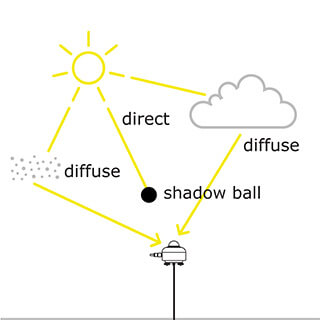
to the GHI minus the direct sunlight contribution.
A pyranometer can measure the DHI by blocking the
direct sunlight with a shadow ball or shadow ring.
Finally, many weather stations also benefit from measuring the reflected solar irradiance from the surface. The ratio of reflected solar irradiance to GHI is known as albedo, which plays a very important role in the local energy balance, see: What is albedo? Especially in areas where the albedo changes significantly throughout the year (e.g., by snow or vegetation) it is important to measure the reflected solar irradiance. This is done by using a downward facing pyranometer. In combination with an upward facing pyranometer it is known as an albedometer, which can measure the albedo of the surface.
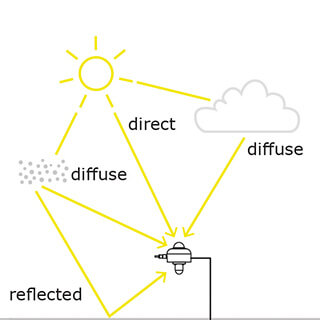
surface. How much sunlight is reflected depends on the
albedo of the surface. The albedo can be measured by
measuring the GHI and the reflected irradiance.
2. The required accuracy
An important consideration is the required accuracy of the weather station that is necessary for its application. First, it is important to make a distinction between thermopile pyranometers and photovoltaic pyranometers, then we will briefly discuss the different accuracy classes described by ISO 9060.
Pyranometers often come in two variants: thermopile and silicon photocell pyranometers. Generally, thermopile pyranometers will yield more accurate measurements than silicon pyranometers, see: What is a thermopile?. This is because silicon photocells can only measure a portion of the entire solar spectrum, while a thermopile pyranometer measures the entire solar spectrum. Silicon photocells are calibrated under clear sky conditions to yield similar measurements to thermopile sensors. However, using silicon photocells in cloudy skies can induce significant measurement errors. Therefore, accurate weather stations often favour thermopile pyranometers.
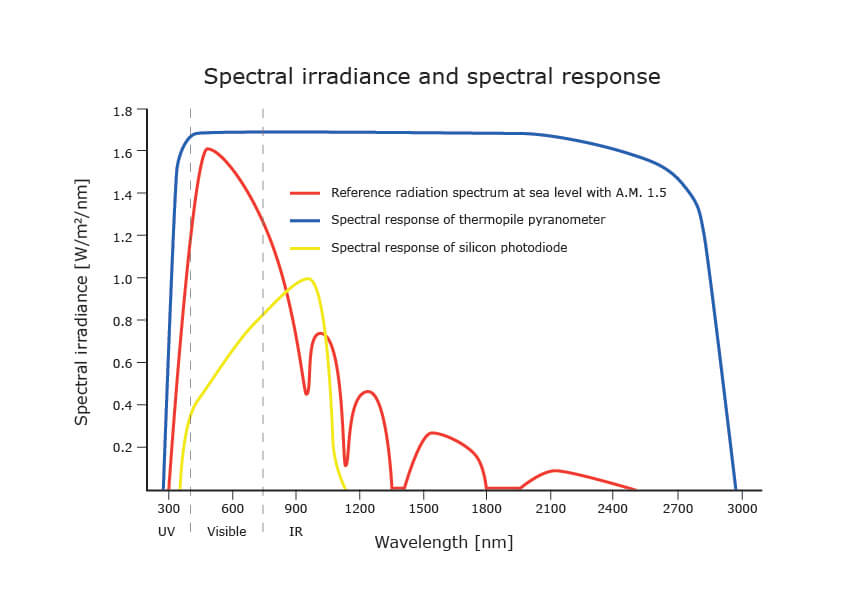
respond inconsistently to a fraction of the solar spectrum. Therefore, thermopile pyranometers are preferred for accurate measurements.
The accuracy of a pyranometer is classified according to the ISO 9060 standard. There are three accuracy classes: A, B and C. Class C is the least accurate and class A is the most accurate, where the achievable accuracy improves by a factor of 2 between each class.
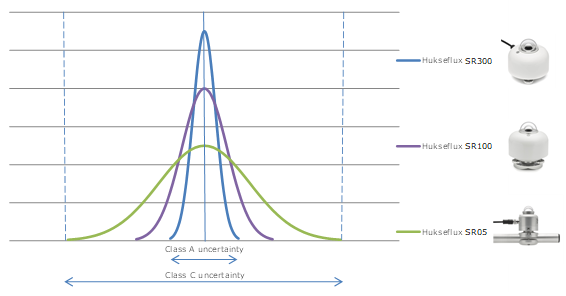
The measurement uncertainties decrease with a factor of 2 between the different classes.
What class of pyranometer a weather station needs, depends on its application and the desired maintenance frequency. For example, the World Meteorological Organization (WMO) recommends the use of at least class B pyranometers for meteorological networks. Modern meteorological networks often use class A pyranometers. For weather stations where regular maintenance is difficult or accurate results are not crucial, class C pyranometers can be used. For example, weather stations in remote locations or agricultural weather stations.
3. The climate
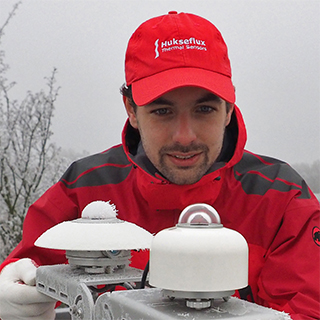
measurements of pyranometers. Therefore, heated
pyranometers are important for year-round data availability.
For weather stations, it is important that they can provide reliable data year-round. This means that they must function throughout the different seasons and for all types of weather. Especially in humid or cold climates this can pose a problem, because of dew forming and frost. This hinders the collection of solar irradiance data, as it alters the amount of radiation that reaches the sensor. Therefore, it is suggested to use an internally heated and ventilated pyranometer for locations where dew and frost are expected to occur for more than 2% of the sunshine duration. The heating and ventilation will prevent frost and dew forming on the sensor, which mitigates the negative effects on sensor performance.
Longwave irradiance sensors in weather stations
We saw that measuring solar irradiance is important for understanding the local energy balance. However, it does not give the complete picture. The balance does not yet account for longwave irradiance. The earth emits longwave radiation, which is a form of thermal radiation. The atmosphere partially reflects this longwave radiation back to earth, known as the greenhouse effect.
Therefore, it is necessary to measure the longwave irradiance for some weather station applications. A pyrgeometer can measure the longwave irradiance. We will discuss how pyrgeometers can be included in weather stations for longwave irradiance measurements.
1. Downward facing pyrgeometers
A downward facing pyrgeometer measures the longwave irradiance of the earth. Pyrgeometers can measure the surface temperature, since longwave irradiance is related to it. Measuring the surface temperature is important for many weather stations. It is an important parameter in weather forecasting and climate research. Moreover, agricultural weather stations with a pyrgeometer can detect frost, creating a system that warns farmers of frost events.
2. Upward facing pyrgeometers
An upward facing pyrgeometer measures the longwave irradiance that the atmosphere sends back to earth. This incoming longwave radiation promotes the melting of ice and snow. This is because ice and snow typically reflect solar energy very well, while almost fully absorbing the energy of longwave radiation. Therefore, some weather stations measure the incoming longwave irradiance in combination with the solar irradiance to determine how much energy the snow receives. This can be used to research and monitor snow and ice melting.
3. Net radiometers
A net radiometer is a device that combines an upward facing pyranometer and pyrgeometer with a downward facing pyranometer and pyrgeometer. It measures all types of incoming and outgoing radiation, giving a complete picture of the local net radiation. The net radiation indicates how much radiation energy is used for processes like evaporation or photosynthesis.
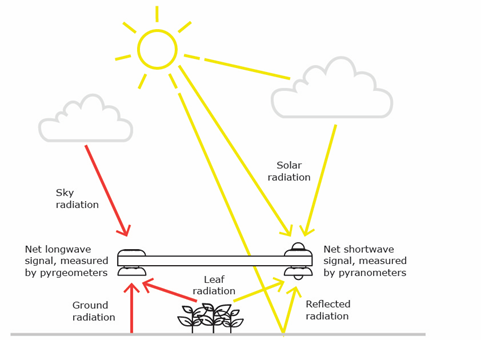
The pyranometers measure the net solar irradiance and the pyrgeometers measure
the net longwave irradiance.
Because of the important role of net radiation in the climate, weather stations often include net radiometers when used for long-term climate research. Monitoring changes in net radiation can give valuable information on how the local climate is changing over time.
Conclusion
For many weather stations, solar irradiance sensors and long-wave irradiance sensors are important for monitoring effects ranging from evaporation to photosynthesis. Therefore, it is important to use sensors that accurately determine the relevant types of radiation.
For measuring solar irradiance, which is crucial in almost all weather stations, pyranometers are an excellent option. They provide reliable measurements for the entire solar spectrum and come in three different accuracy classes, making them suitable for a wide range of applications. Especially internally heated and ventilated pyranometers are suitable because of their year-round data availability, important for many weather station applications.
To get a better understanding of the local energy balance, many weather stations also include pyrgeometers to measure the longwave irradiance. Pyrgeometers are key components in net radiometers, which are valuable in long-term climate research.








